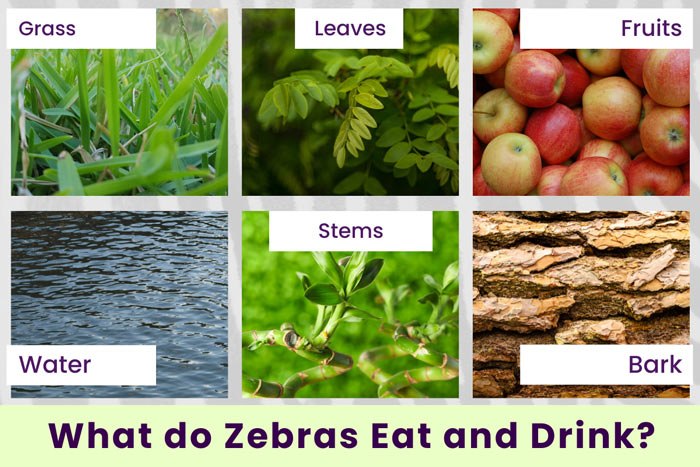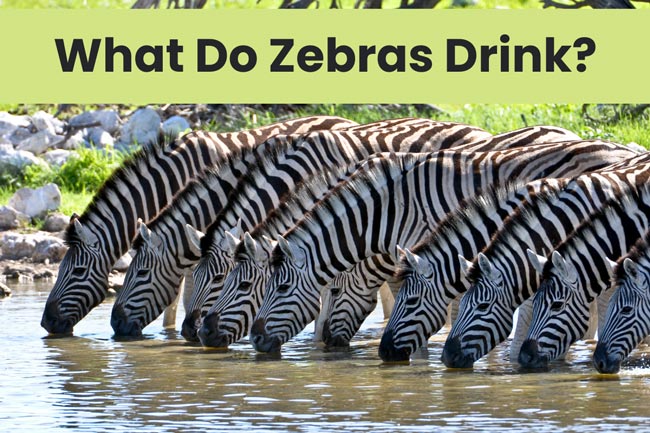What Do Zebras Eat and Drink? – In The Wild
We all know an animal that has black and white stripes on its coat. Yes, its name is zebra. Wild zebras are popular herbivores in the grasslands. Their diet consists mostly of vegetation found in their natural habitat. Here, we will look in detail at what zebras eat and drink in the wild to live a healthy life.
Table of Contents
Introduction: Diet of Zebras
Being herbivores, zebras graze primarily on grasses, however, they will sometimes graze on the leaves and stems of shrubs. Each day, they graze for several hours, using their powerful front teeth to remove the grass’s tips. They use their back teeth to chew it and make it easy to swallow.
Zebras prefer to graze on tall grasses since their stomachs are better suited to digesting tall grasses in savannas than most other herbivores. They do this to leave plenty of grass for other herbivores that eat only short grass.
Zebras are able to eat tough plants and grasses because of their strong teeth. Also, they grind their food to break it down. It lets them get the most out of their food and get the nutrients they need.
Here’s an interesting fact because they eat so much every day, their teeth get smaller over time. But zebras won’t lose their teeth because new ones are always growing in, ready to help them eat more!
Zebras consume a lot of food to make up for the fact that they primarily eat low-nutrient foods. Zebras can consume and chew their food nearly 18 hours daily.
Tall grasses like Bermuda grass and red grass comprise 90% of a zebra’s diet. Zebras also consume herbs, shoots, leaves, shrubs, bark, twigs, and other vegetation.
What do Zebras Eat In the Wild?
As zebras are herbivores; their diet mostly comprises grasses or other fibrous plant components. Even though, based on what area they inhabit, one’s diet might vary slightly. Following are some examples of the typical plant species that zebras eat in the wild:
Grasses
Zebras eat grass in their natural habitats, which are grasslands and savannas. They prefer short, green grasses, which are high in nutrients and easier to digest. Zebras may consume longer and tougher grasses during the dry season when fewer grass types are found. They typically eat buffalo grass, red oat grass, Bermuda grass, star grass, and occasionally couch grass. Wild zebras need these grass varieties for energy and nutrition to stay healthy, active, and strong.
Leaves
Besides grasses, zebras sometimes eat leaves from trees and bushes in their natural habitat. They prefer young, tender leaves that are easier to chew and digest. They eat leaves mainly during dry seasons when grasses are scarce. Their preferred leaves include those from acacia, mopane, and Baobab trees. These leaves give them an alternative source of nutrients.
Stems
Plants have stems that hold leaves and flowers up. Zebras also consume the stems of various plants, grasses, and leaves. They like delicate stems that are moderately woody and stiff. Zebras also use their front teeth to pull stems from the ground and bring them into their mouths. The wild zebras occasionally eat stems such as bamboo stems, river bushwillow stems, and various shrub stems, usually when grass isn’t available. They get nutrition and fiber from eating stems, which keeps them healthy.
Bark
The diet of Zebras also includes bark. The bark is the outer covering of trees. Bark isn’t their main food, but it can be part of their diet if they need to survive in the wild. They may consume tree bark during droughts when vegetation is scarce. They use their strong teeth to strip the bark off and chew it for nutrients. The zebras also do it to adapt to their environment and find food. For example, they may eat the bark of acacia trees.
Fruits
Despite not being a major part of one’s diet, zebras would also eat fruit whenever it’s obtainable. Wild zebras sometimes eat fallen fruit from trees. Here zebras will see a change in their taste because all fruits taste different. Wild zebras might occasionally eat berries, bananas, apples, etc., which give them vitamins and nutrients.
Generally, the diet of zebras includes a wide variety of plants, allowing them to survive in several diverse situations.
“Zebras are primary consumers. Check out how energy flows through an ecosystem.”
What Do Zebras Drink In the Wild?
Water is essential for Zebras. Water keeps wild zebras hydrated and healthy. Depending on their habitat, local rivers, lakes, and waterholes give them water. During dry seasons, when water is hard to find, zebras travel in groups to find water. Zebras migrate or move following the rains during the dry season in Africa when minimal rainfall occurs. Large herds of Zebras will wander up to 700 miles to find food and water. They have been observed to consume up to one gallon of water simultaneously! Grevy’s Zebras can go up to five days without water in the wild.
What Do Wild Zebras Not Eat?
Zebras don’t consume meat. Wild zebras will also not eat anything that is not naturally available. For example, they will not find dairy products, processed foods, sweets, etc. The irony would be that zebras frequently kill deer, antelope, and then even sometimes adult zebras while leaving the injured or dead animal unharmed. The carnivores later consume these animals. The primary energy source for this remarkably intelligent wild animal is grass. Only grass comprises 90% of their diet; the remaining 10% may consist of herbs, roots, aquatic plants, leaves, or legumes.
“Zebras are mammals. Read more about the taxonomic classification of animals.”
Conclusion
As herbivores, grasses, leaves, and stems comprise most of a zebra’s diet. Most of their time is spent grazing in grasslands. Depending on the season and the area they live in, different vegetation types are consumed. Plains zebras, for instance, may eat shorter grasses during the wet season and then shift to taller grasses during the dry season. On the other hand, mountain zebras may eat a wider range of vegetation, such as bark, bushes, and even succulents. They get their drinking water from rivers and lakes near them. Zebras have a unique digestive system and specialized microorganisms to digest dense and fibrous plant material. Also, it should be noted that zebras are feeders and grazers, and their diet plays a huge role in their survival. It’s important to respect their dietary habits so they can thrive in the wild.


